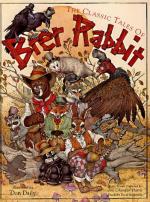|
This section contains 3,511 words (approx. 12 pages at 300 words per page) |

|
SOURCE: "Uncle Remus: Puttin' on Ole Massa's Son," in The Southern Literary Journal, Vol. XV, No. 1, Fall, 1982, pp. 83-90.
In the following essay, Hedin detects subversiveness not only in the tales related by Uncle Remus but also in Uncle Remus's narration and his interaction with the young boy to whom he tell the tales.
In Joel Chandler Harris's collections of Uncle Remus tales, scholars have noticed an apparent contradiction between the tales themselves and the framework of teller and audience that Harris created as a setting for them. Folklorists and literary critics now tend to agree that Brer Rabbit and the other seemingly weak animals who inhabit the tales are ultimately subversive of the plantation myth of docile, contented slaves; for their surface politeness and respect mask an effective survival ethic of cunning, selfinterested manipulation, and even violence against the seemingly strong. Yet in contrast with the thrust...
|
This section contains 3,511 words (approx. 12 pages at 300 words per page) |

|


